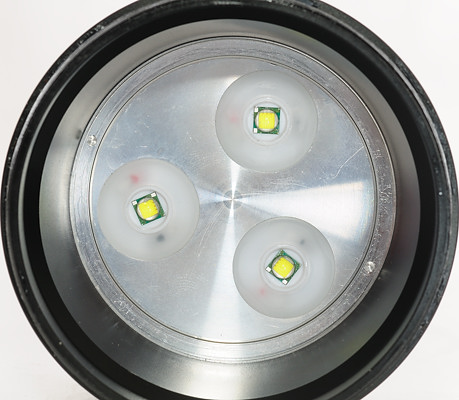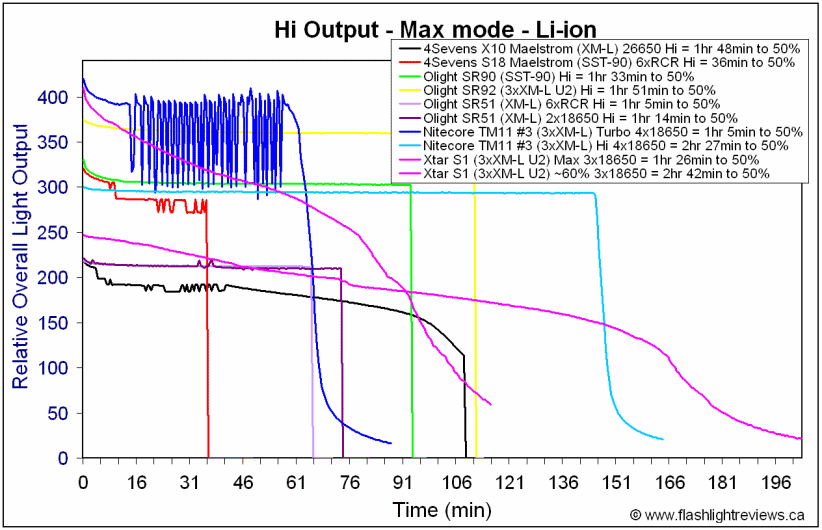I really do not understand you sometimes?
The temperature of the light can also affect this (See my heat chart), I do my runtime with forced airflow on the light.
Your temperature result is good. I see that you have forced airflow, so it's approx 45 deg C @ 13-14 min. I started off at the same temperature as you did, and I got 49 deg C @ 12th min. Nil airflow.
After the Sky Ray 3800 incident, i have sort of stopped doing full bore runs. I must have done > 20 full bore runs on XTAR 2600, Solarforce 2400, TF 2400, NCR18650 on that light. Luckily when the driver got a dead short i was doing protected cells and not NCR18650. Definitely i'd be looking at some expensive repairs to my decor then. (area full of tempered glass!)
I really do not understand you sometimes?
At the 55th minute, the output is 80% (I misread it a little to be the 60th minute). The "knee" refers to an important aspect of any graph and this represents where something is really useful. For example, Mitro refers to Sanyo 2600 cells to have the best knee in his discharge graphs. If you dabble in hifi/audio, a frequency graph has got to have a lower cut off point and it is usually the f3 or -3dB point before the graph really dives. In the above graph, we choose 80% and it is the point where the graph really dives after that.
Should have clarified that technical part for you. Hope that helps....
Your temperature result is good. I see that you have forced airflow, so it's approx 45 deg C @ 13-14 min. I started off at the same temperature as you did, and I got 49 deg C @ 12th min. Nil airflow.
You must not confuse the heat test with the runtime test, they are done separately and with very different test conditions and purpose.
The runtime is with forced airflow and a normal battery load, this is a simulation of actual use conditions (Light in hand and moved around).
In the heat test the light is tied down in the test bench and supplied with power from a bench power supply (Adjusted to average battery voltage i.e. 3.7 volt for LiIon), the purpose is to see how the light handles high temperature, secondary how good the cooling is.
It does not look like the S1 has any temperature throttling and the led does get hot, but not dangerous hot (The XM-L datasheet has a curve with relative output depending on temperature).
You must not confuse the heat test with the runtime test, they are done separately and with very different test conditions and purpose.
The runtime is with forced airflow and a normal battery load, this is a simulation of actual use conditions (Light in hand and moved around).
In the heat test the light is tied down in the test bench and supplied with power from a bench power supply (Adjusted to average battery voltage i.e. 3.7 volt for LiIon), the purpose is to see how the light handles high temperature, secondary how good the cooling is.
It does not look like the S1 has any temperature throttling and the led does get hot, but not dangerous hot (The XM-L datasheet has a curve with relative output depending on temperature).
I see...I am looking at the blue graph actually. So I am getting a bit hotter temperatures but not a lot. Usually i am not worried about the LEDs, in my experience it is usually the driver that cooks first. heh...
Can you show a pic off the leds without the reflector please.
Here it is:

So it's regulated after all? :| So selfbuils sample was DD? :|


The strange thing is that on Med and Low mode I can still see that DD-like curve, so dunno it's heat related. Strange :|
So it's regulated after all? :| So selfbuils sample was DD? :|
The strange thing is that on Med and Low mode I can still see that DD-like curve, so dunno it's heat related. Strange :|
It is some sort of regulation, but it does not work as well on the lover brightness, yes this is strange.
As can also be seen from the heat test, heat will reduce output considerable, but I do believe that Selfbuild uses a fan for runtime (like me).
Yup, agreed with heat related problems for HI, but on Low modes I dunno heat will affect :| Xtar need to polish that :bigsmile:
Great review anyway ;) :crown:
HKJ: Is this your website as well?
Yes, and all pictures in the review are hosted on that size.
Just wanted to say thanks for all!!
( and what happens with your XTAR torches? so many review samples you got for free :D )
( and what happens with your XTAR torches? so many review samples you got for free
)
Mostly they get used in my beamshot comparisons, but sadly not this one (I had a bad day and made a mistake with my power supply ).
).
sorry to hear about your bad day, omg :cry:
after you're done with a torch review, you can keep the torch and dont have to return it, right? They remunerate you with the torches.
Better than a cheque $)
after you're done with a torch review, you can keep the torch and dont have to return it, right? They remunerate you with the torches.
Better than a cheque $)
That is the standard deal, it is the same for chargers and batteries.
But if you check the reviews on my website, you will see that many of the light/chargers/batteries are some I bought (I always write a note, when I get the stuff for free).
Great review sir! Thanks very much for the excellent details. Frontpage'd and Sticky'd.
2pcs of the UCL 72.7mm x 1.85mm thick gives 1.48% cut in output. (each one is 0.74%). Original glass is nearly 10%. AR tint is green in colour. No rattle, the bezel screws back on ok but there is a very slightly bigger gap between the bezel cap and body than before. Original glass is 3.5mm and this is 3.7mm, a minor difference of 0.2mm. In reality you absolutely won't notice it.
HKJ, since you've reviewed the S1 and most or all of Xtar's 18650 batteries, would you be able to say which ones are most suitable for use in the S1, for someone who wants the output to stay as high as possible, even if that means less run-time?
HKJ, since you've reviewed the S1 and most or all of Xtar's 18650 batteries, would you be able to say which ones are most suitable for use in the S1, for someone who wants the output to stay as high as possible, even if that means less run-time?
You have to look at the voltage sweep for high. This shows that the light as stable output for any voltage above 3.5 volt and it needs 7.5 ampere. Because it uses 3 batteries in parallel you can divide the 7.5 ampere with 3, i.e. 2.5 ampere for each battery.
With these data you can look in my battery summary (or the full comparison, that I will publish soon). You want the discharge down to 3.5 volt, but I only have a 3.4 volt or 3.6 volt. With 2.5 ampere you want somewhere between 2A (cyan) and 3A (yellow).
I.e. the batteries with the longest cyan and yellow bars in both charts are the best.
I would go for the Spark or Xtar 2600, they are best in the 3.4 volt chart (i.e. the light has dimmed slightly).

